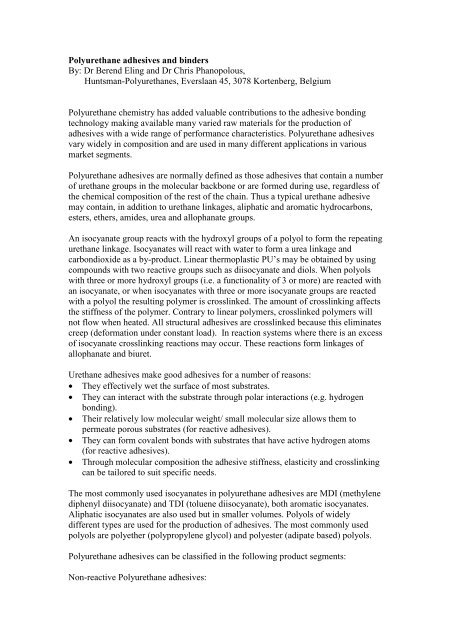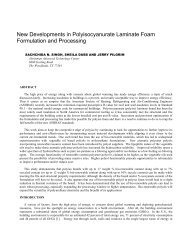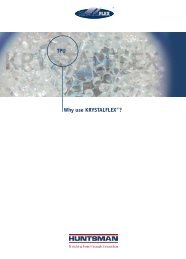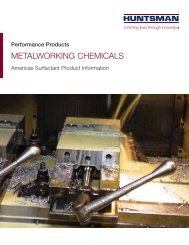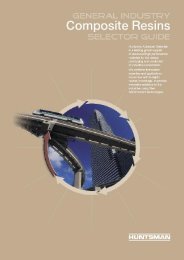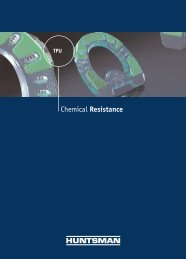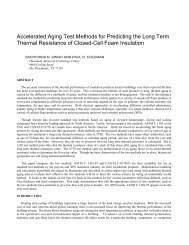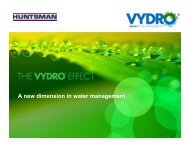Polyurethane adhesives and binders
Polyurethane adhesives and binders
Polyurethane adhesives and binders
You also want an ePaper? Increase the reach of your titles
YUMPU automatically turns print PDFs into web optimized ePapers that Google loves.
<strong>Polyurethane</strong> <strong>adhesives</strong> <strong>and</strong> <strong>binders</strong><br />
By: Dr Berend Eling <strong>and</strong> Dr Chris Phanopolous,<br />
Huntsman-<strong>Polyurethane</strong>s, Everslaan 45, 3078 Kortenberg, Belgium<br />
<strong>Polyurethane</strong> chemistry has added valuable contributions to the adhesive bonding<br />
technology making available many varied raw materials for the production of<br />
<strong>adhesives</strong> with a wide range of performance characteristics. <strong>Polyurethane</strong> <strong>adhesives</strong><br />
vary widely in composition <strong>and</strong> are used in many different applications in various<br />
market segments.<br />
<strong>Polyurethane</strong> <strong>adhesives</strong> are normally defined as those <strong>adhesives</strong> that contain a number<br />
of urethane groups in the molecular backbone or are formed during use, regardless of<br />
the chemical composition of the rest of the chain. Thus a typical urethane adhesive<br />
may contain, in addition to urethane linkages, aliphatic <strong>and</strong> aromatic hydrocarbons,<br />
esters, ethers, amides, urea <strong>and</strong> allophanate groups.<br />
An isocyanate group reacts with the hydroxyl groups of a polyol to form the repeating<br />
urethane linkage. Isocyanates will react with water to form a urea linkage <strong>and</strong><br />
carbondioxide as a by-product. Linear thermoplastic PU’s may be obtained by using<br />
compounds with two reactive groups such as diisocyanate <strong>and</strong> diols. When polyols<br />
with three or more hydroxyl groups (i.e. a functionality of 3 or more) are reacted with<br />
an isocyanate, or when isocyanates with three or more isocyanate groups are reacted<br />
with a polyol the resulting polymer is crosslinked. The amount of crosslinking affects<br />
the stiffness of the polymer. Contrary to linear polymers, crosslinked polymers will<br />
not flow when heated. All structural <strong>adhesives</strong> are crosslinked because this eliminates<br />
creep (deformation under constant load). In reaction systems where there is an excess<br />
of isocyanate crosslinking reactions may occur. These reactions form linkages of<br />
allophanate <strong>and</strong> biuret.<br />
Urethane <strong>adhesives</strong> make good <strong>adhesives</strong> for a number of reasons:<br />
• They effectively wet the surface of most substrates.<br />
• They can interact with the substrate through polar interactions (e.g. hydrogen<br />
bonding).<br />
• Their relatively low molecular weight/ small molecular size allows them to<br />
permeate porous substrates (for reactive <strong>adhesives</strong>).<br />
• They can form covalent bonds with substrates that have active hydrogen atoms<br />
(for reactive <strong>adhesives</strong>).<br />
• Through molecular composition the adhesive stiffness, elasticity <strong>and</strong> crosslinking<br />
can be tailored to suit specific needs.<br />
The most commonly used isocyanates in polyurethane <strong>adhesives</strong> are MDI (methylene<br />
diphenyl diisocyanate) <strong>and</strong> TDI (toluene diisocyanate), both aromatic isocyanates.<br />
Aliphatic isocyanates are also used but in smaller volumes. Polyols of widely<br />
different types are used for the production of <strong>adhesives</strong>. The most commonly used<br />
polyols are polyether (polypropylene glycol) <strong>and</strong> polyester (adipate based) polyols.<br />
<strong>Polyurethane</strong> <strong>adhesives</strong> can be classified in the following product segments:<br />
Non-reactive <strong>Polyurethane</strong> <strong>adhesives</strong>:
1. Solvent borne <strong>adhesives</strong>. <strong>Polyurethane</strong> solvent <strong>adhesives</strong> consist of a high<br />
molecular weight hydroxyl terminated polyurethane (MW approximately 100,000)<br />
dissolved in a solvent. The polyurethanes are obtained by reacting a high<br />
molecular weight polyester diol with a diisocyanate <strong>and</strong> differ in solution<br />
viscosity <strong>and</strong> crystallisation tendency. The polymer solutions are applied to both<br />
surfaces to be bonded. Some time is allowed for the solvents to evaporate <strong>and</strong> the<br />
surfaces are then pressed together, at which point interdiffusion of the polymer<br />
chains will occur.<br />
2. Hot melt <strong>adhesives</strong>. These <strong>adhesives</strong> also consist of high molecular weight<br />
hydroxyl-terminated polyurethane. Chemically <strong>and</strong> structurally the polymers used<br />
in solvent borne <strong>and</strong> hot melt <strong>adhesives</strong> are related. Hot melt <strong>adhesives</strong> are most<br />
commonly applied as adhesive film in lamination type of applications. These<br />
<strong>adhesives</strong> form the adhesive bond by cooling from the molten state.<br />
3. Water based <strong>adhesives</strong>. These <strong>adhesives</strong> are high molecular weight polyurethanes<br />
dispersed in water (PU dispersions, or PUD’s). The water carrier is eliminated<br />
during use, leaving the precipitated <strong>and</strong> coalesced polymer to form the adhesive<br />
bond.<br />
Reactive <strong>Polyurethane</strong> <strong>adhesives</strong>:<br />
1. One component <strong>adhesives</strong>. This is a liquid isocyanate-terminated polyurethane<br />
with a relatively high molecular weight (prepolymer) <strong>and</strong> rather low remaining<br />
isocyanate content. The prepolymers are prepared by reacting an excess of<br />
isocyanate with high molecular weight polyester or polyether polyols. The free<br />
isocyanate groups react with moisture from the environment to form urea<br />
linkages. If the functionality of the prepolymer is larger than two (i.e. contains<br />
more than two isocyanate groups per molecule) the cured film will be chemically<br />
crosslinked.<br />
2. Two component <strong>adhesives</strong>. Such <strong>adhesives</strong> consist of two relatively low<br />
molecular weight components: the polyol <strong>and</strong> isocyanate. When the two<br />
components are mixed they form urethane groups in the adhesive films. The<br />
polyols are usually of the ether or ester type. The isocyanates <strong>and</strong> polyols<br />
employed may have a functionality of two or higher. In the latter case a<br />
crosslinked polymer film is formed.<br />
3. Reactive Hot Melt. Reactive hot melt <strong>adhesives</strong> are highly viscous or solid<br />
prepolymers with a low melting point. The prepolymers are produced from solid<br />
(i.e. crystalline) polyester polyols <strong>and</strong> isocyanate <strong>and</strong> have a low number of free<br />
isocyanate groups. The adhesive is applied above its melting point <strong>and</strong> bond<br />
through the physical process of cooling (like a conventional hot melt adhesive) as<br />
well as through reaction with ambient moisture (as a one component adhesive).<br />
4. Wood<strong>binders</strong>: Aromatic isocyanates (predominantly MDI) are used as <strong>binders</strong> to<br />
manufacture oriented str<strong>and</strong> board (OSB), medium density fibreboard (MDF) <strong>and</strong><br />
particleboard. For these boards, the isocyanate is blended with wood str<strong>and</strong>s,<br />
fibres <strong>and</strong> chips, respectively. The cure takes place in a press at about 200°C. The
curing reaction is predominately via the reaction with water <strong>and</strong> thus the<br />
formation of urea groups. Additionally, a wide range of reactions with wood<br />
components will also occur depending on the temperature, moisture content <strong>and</strong><br />
the specific location within the wood matrix.<br />
5. Crosslinkers. Although crosslinkers are not seen as ‘<strong>adhesives</strong>’ perse, they do<br />
improve the adhesive properties of solvent <strong>and</strong> water born <strong>adhesives</strong>. Solvent<br />
borne crosslinkers are added to solvent born polyurethane or chloroprene<br />
<strong>adhesives</strong>. Water borne ‘emulsifiable’ isocyanates are added to latex <strong>and</strong> PUD<br />
<strong>adhesives</strong>. In the bond crosslinking reactions occur <strong>and</strong> the resulting crosslinked<br />
adhesive has improved mechanical properties as compared to the non-crosslinked<br />
<strong>adhesives</strong>.<br />
Market segments:<br />
Based on their outst<strong>and</strong>ing properties, their simple <strong>and</strong> economical processing <strong>and</strong><br />
their high strength, polyurethane <strong>adhesives</strong> have found broad use in many application<br />
areas. The segments in which polyurethane <strong>adhesives</strong> are used most are: footwear<br />
industry, construction, woodworking, transportation, packaging <strong>and</strong> assembly<br />
operations. However, in certain areas of application, such as indirect food contact,<br />
approvals for use need to be obtained from appropriate regulatory authorities.


